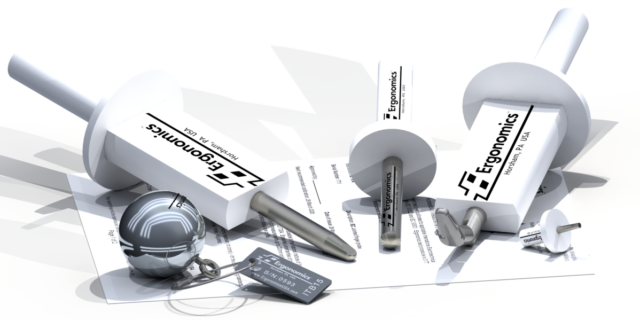Probe Kit for IEC 60950 – Model PK950

Safety Test Probe Kit PK950 contains the probes necessary for testing to IEC 60950:
- JFP10 – Jointed Finger Probe
- UFP20 – Unjointed (Rigid) Finger Probe
- TPP15 – Test Pin Probe
- ITB15 – Ø50mm Impact Test Ball, 500 grams
- TAP40 – Telecommunications Access Probe
This kit includes a case to protect and safely transport your probes.
Accessibility probes are used to test the size of openings to ensure that fingers and objects do not have access to hazardous parts in equipment and machinery. All of the probes in the kit are fabricated in the USA. All components are precisely made from stainless steel and Delrin. These materials ensure a long life and satisfactory use due to their high quality and durability.
1. Jointed Finger Probe JFP10: Precision probe which follows IEC specifications and meets the latest requirements. The design features a palm simulator to prevent misuse and restricted joint movement, which simulates human finger movement. The probe is manufactured of stainless steel. The handle is made of Delrin®. This model meets CSA, IEC, UL and other industry requirements.
2. Unjointed Finger Probe UFP20: Identical to the Jointed Finger Probe except that it is rigid. Used for forceful insertion where the flexibility of the JFP10 would be a hindrance. The handle is designed with a screw tap for use with a force gauge. Meets CSA, IEC, UL and other industry requirements.
3. Test Pin Probe TPP15: A quality probe used to test for accessibility of small objects. Manufactured of durable Delrin® with a stainless steel tip, it is machined with precision to meet industry standards. Meets CSA, IEC, UL and other industry requirements.
4. Impact Test Ball ITB15: Specially machined ball to test impact resistance. This is called for in IEC 60950, UL 78 and many other product specifications such as for the automotive industry. The probe is made of chrome plated steel for durability.
5. Telecommunications Access Probe TAP40: Found in IEC 60950, UL and CSA standards, it is used to check for limited access to telecommunication voltages (TNV), mainly telephone jacks and operator areas.
